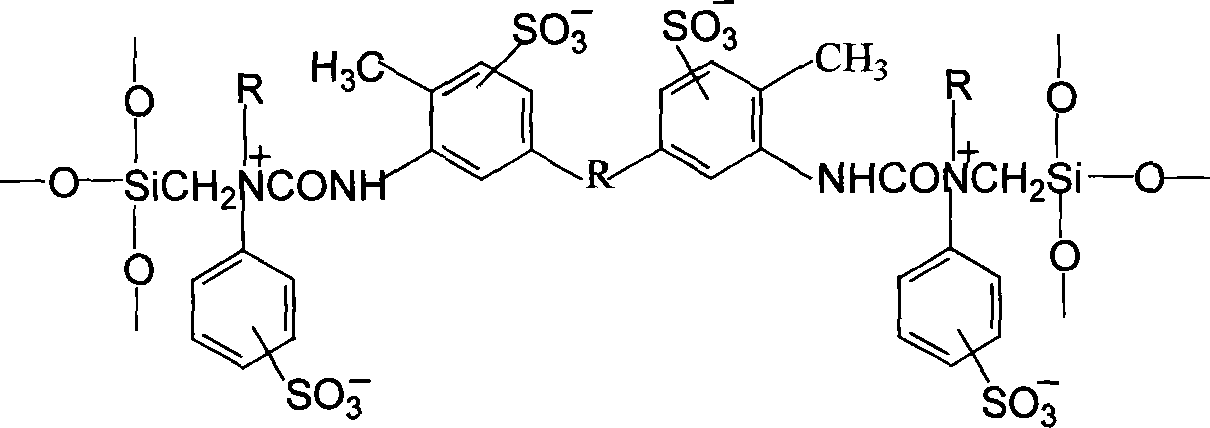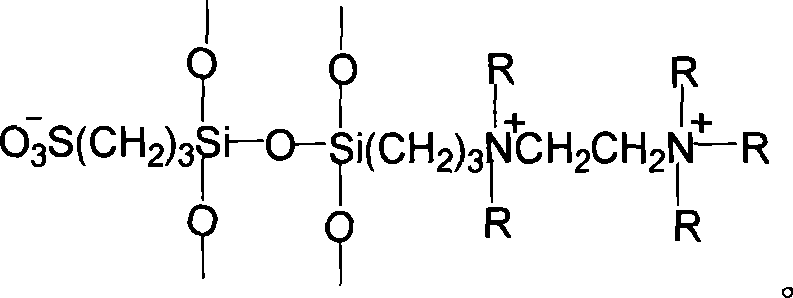Membrane material of inorganic ¿C organic hybrid pair of amphoteric ion, and preparation method
A zwitterion, organic hybrid technology, applied in chemical instruments and methods, membrane technology, semi-permeable membrane separation, etc., can solve the problems of poor temperature resistance, limited application value, inability to ion exchange membrane, etc., and achieve high temperature resistance. , The effect of large charge capacity and good flexibility
- Summary
- Abstract
- Description
- Claims
- Application Information
AI Technical Summary
Problems solved by technology
Method used
Image
Examples
Embodiment 1
[0030] Example 1. Preparation of an inorganic-organic hybrid containing anion and cation exchange groups with the reactant ratio PEG-1000:anilinomethyltriethoxysilane (ND-42):bromoethane=1:2:4 Zwitterion Pair Membrane Materials
[0031] Using a 250ml three-neck flask equipped with a magnetic stirrer, a nitrogen inlet and a dropping funnel, add N,N-dimethylformamide (DMF), and add polyethylene glycol (PEG-1000) in a nitrogen atmosphere and a DMF solution of diisocyanate (TDI), and then add anilinomethyltriethoxysilane (ND-42) solution dropwise under stirring, and stir the reaction at 35°C. After reacting for 6 hours, add fuming sulfuric acid (20% SO 3 ) for sulfonation reaction, washed several times and then dried to remove unreacted substances to obtain a hybrid precursor containing cation exchange (acidic) groups; dissolve the charged hybrid precursor in DMF, and then add Bromoethane is reacted for 24 hours to graft an alkyl group on the molecular chain to obtain an anion e...
Embodiment 2
[0036] Example 2. Preparation of an inorganic-organic hybrid containing anion and cation exchange groups with reactant ratio PEG-1000:anilinomethyltriethoxysilane (ND-42):bromoethane=1:2:4 Zwitterion Pair Membrane Materials
[0037] Using the same device and operating process as in Example 1, only changing the order of sulfonation and amination reactions, that is, at 60 ° C, using the experimental procedure of first amination reaction and then sulfonation reaction, thus also can get Inorganic-organic hybrid zwitterion membrane material containing both anion and cation exchange groups.
[0038] The results of TGA and DrTGA thermal analysis show that the initial thermal degradation temperature of the hybrid membrane material is about 300°C, and the thermal degradation temperature is about 405°C; while the thermal degradation temperature of the positively charged hybrid membrane material containing amine groups is 370°C; It can be seen that the thermal stability of the hybrid zw...
Embodiment 3
[0041] Example 3. Preparation with reactant ratio mercaptopropyltrimethoxysilane: N-β-aminoethyl-γ-aminopropyltrimethoxysilane: ethyl bromide=1:1:4, containing anion and cation exchange Inorganic-Organic Hybrid Zwitterion Pair Membrane Materials
[0042] Measure N-β-aminoethyl-γ-aminopropyltrimethoxysilane and mercaptopropyltrimethoxysilane, dissolve them in DMF respectively, add bromoethane, and carry out amination reaction at 60°C; adjust N - The molar ratio of β-aminoethyl-γ-aminopropyltrimethoxysilane to mercaptopropyltrimethoxysilane and ethyl bromide is 1:1:4, and the stirring is continued for 6 hours at 30°C to obtain Sol-gel, the product is dried at 70°C to prepare a hybrid precursor containing an anion exchange group. This hybrid precursor is used as a raw material, dissolved in DMF, and then mercaptopropyl is oxidized with a hydrogen peroxide (30%) solution to generate a cation exchange group, and then analyzed by infrared spectroscopy and determined The content of...
PUM
| Property | Measurement | Unit |
|---|---|---|
| thermal degradation temperature | aaaaa | aaaaa |
| thermal degradation temperature | aaaaa | aaaaa |
| thermal stability | aaaaa | aaaaa |
Abstract
Description
Claims
Application Information
 Login to View More
Login to View More - R&D
- Intellectual Property
- Life Sciences
- Materials
- Tech Scout
- Unparalleled Data Quality
- Higher Quality Content
- 60% Fewer Hallucinations
Browse by: Latest US Patents, China's latest patents, Technical Efficacy Thesaurus, Application Domain, Technology Topic, Popular Technical Reports.
© 2025 PatSnap. All rights reserved.Legal|Privacy policy|Modern Slavery Act Transparency Statement|Sitemap|About US| Contact US: help@patsnap.com



